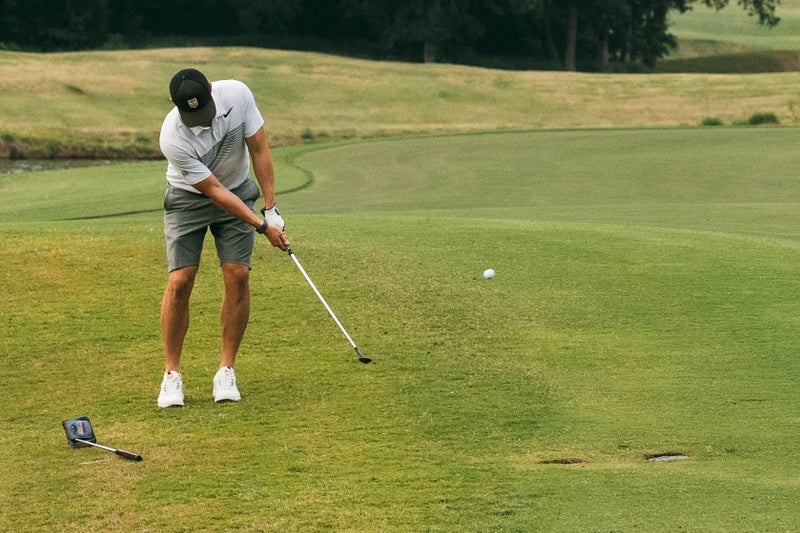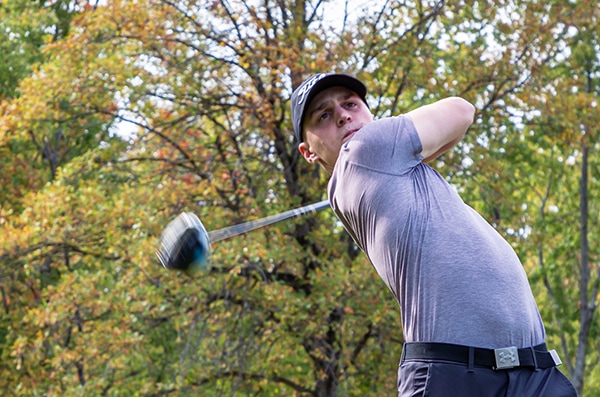-
{{link.label}}{{link.label}}
Putter vs Wedge: When Should You Use Them
On this page
Golf is all about decision-making and thinking through every one of your shots before stepping up to hit the ball. These decisions become even more complicated when you get closer to the hole as you have more playing options at your disposal.

No situation better encapsulates this dilemma than when your ball is sitting on the fringe of the green. Faced with this situation, golfers will have to decide between two options. The first, using your putter off the green, the second, using your wedge on a short distance.
The goal of this guide is to help you approach this situation with confidence so that you can quickly identify which option is best for you.
This greenside guide will help you:
- Understand how to hit both your putter and your wedge from the fringe
- Identify the situation on the course to assess which club is your best option
- Improve your short game when you’re within a few feet of the green
What is a « greenside » golf ball position?
Just like the name suggests, a greenside golf ball will be sitting on the ground, very close to the green. Most of the time, these greenside golf balls will be sitting on the fringe, which is a shorter cut than the fairway, but a longer one than the green.

Greenside doesn’t necessarily mean that the ball is sitting on the fringe, but it does mean that it is sitting within a very short distance from the green. Usually, up to 10 feet away from the green is still considered greenside, even if your ball is in the fairway or the rough.
How to use your putter from just off the green?
Pulling your putter out of your bag when your ball is just short of the green is always a smart move. By using your putter, you reduce the risk of hitting a thin shot that might run across the green. You can almost always rely on your putter when your ball is only a short distance away from the green.
What you should keep in mind when putting off the green:
- Look out for any impediments in the ground between your ball and the green
- Evaluate how much distance is between your ball and the green
- Take into consideration the height of the different cuts of grass between your ball and the green
- Have a sense of the speed of the greens

The first detail you should look out for before using your putter from off the green is to look out for impediments in the ground that could affect your strike. This could be as minor as a missing patch of grass for a divot, or as severe as a full sprinkler head leaving a massive hole in the grass.
You should then turn your focus to evaluating the distance between your ball and the edge of the green so that you can figure out how much power you’ll need to add to your strike. You’ll need to hit the ball harder than you usually do when putting off the green as the ball won’t roll as easily on the fringe, the fairway, or even the rough.
Don’t forget to take into account the height of grass between you and the green. The loft angle in the clubface of your putter will come in handy in this situation. If you didn’t know, your putter has a very slight loft angle that picks the ball off the ground at impact. Giving it more power when you’re off the green will also propel the ball a little higher in the air, helping you to deal with the long grass.
Finally, you must consider the speed of the greens. If you’re playing on a course with long grass and fast greens, you’ll need to make sure that your strike is powerful enough to escape the fringe, the fairway, or the rough, but not too hard that it will roll off the green. Your putting touch will be crucial in such a situation.
How to use a wedge when just off the green?
Opting for a wedge when your ball is sitting next to the green, whether that be on the fringe, in the fairway, or the rough will more than often be a smart decision. Especially if you’re at ease with your wedges and your short game, going with the wedge might be your best bet.
What you should keep in mind when hitting your wedge from just off the green:
- Look out for any impediment in the ground that could affect your stance or your swing
- Determine where you need to land your strike based on your ball position
- Figure out how many rolls your ball will need on the green
- Take into consideration the way your ball is sitting on the ground
.jpg?w=800)
Just like you would if you were to putt the ball, the first thing you should do is look for impediments in the ground. Since you’ll be able to get over obstacles with your wedges, you’ll want to look out for impediments that could affect your stance or your swing.
Next, you’ll want to find the landing spot for your chip shot. Your ball will likely roll once it touches the green and by taking this into account, you’ll be able to decide on a smart landing spot. Depending on the location of the hole, you might need to land the ball short of the green to limit the roll.
Many factors will affect the roll of your golf ball once it’s on the green and you need to establish how far you think it will roll before hitting the ball. The ball will naturally roll further if the green slopes away from you and have a limited roll on an upslope. The amount of spin you put on the ball will also heavily affect the roll of the golf ball.
The positioning of your golf ball on the ground will play a key role in your decision-making. Most golfers will opt for a high-spinning chip shot or a bump and roll, but other types of wedge shots will be available to you. You just need to identify the lie of the golf ball and what shots are available to you.
How can I decide between my putter or my wedge when playing close to the green?
Multiple factors will impact your decision when it comes to choosing either your wedge or your putter on short-distance shots near the green. From the shape and the slope of the green to the location of the pin and how your ball is sitting on the ground, you need to identify these key factors to make your decision.
What you should take into consideration when trying to decide between your wedge and putter:
- The slope of the green
- The speed of the greens
- Hole location
- Impediments between your ball and the hole
- Ball position on the ground
The slope of the green
The slope of the green will play a key role in helping you decide between your wedge and your putter. Is the green sloping away from you? Going with your putter will be your best bet as you’ll be able to hit a lag putt. But keep in mind that hole location also plays a role, which means that if the hole is sitting on a plateau lower than your golf ball, landing a chip shot with limited rollout is just as good an option.
On the other hand, if you’re facing an upwards angle to the hole, you might want to pull a wedge out of your bag. The upward angle of the green will limit the roll on your chip and your wedge will allow you to attack the position of the hole with a more aggressive strike.
Putting upwards is always a good option if there are no impediments in the way, but you’ll want to hit a stronger put as it needs to go up the slope and avoid coming back down to you. Such a situation is very likely to see you leave a putt short.

The speed of the green
Though you might not know the exact pace and speed of the greens of the course you’re playing, you’re still able to access if your putts are rolling a lot or if you need to give them a little more power to reach the hole.
If you’re facing fast-paced greens, you’ll be better off using your putter as you’ll have more control over the roll of the ball once it touches the green.
As for the wedge, feel free to use them when faced with receptive greens that don’t provide a lot of rolls as you’ll once again be able to attack any ball position.
Hole location
As previously mentioned, the location of a hole will also greatly impact your decision when you’re close to the green. Additionally, the area surrounding the hole will also come into play as slopes and plateaus can become challenging.
When faced with a hole location that is close to your ball position, you should strongly consider your putter as the right move. The short distance will be easier to handle with the putter as you’ll be able to keep the ball along the grass.
If the hole is far away from you, or tucked at the opposite end of the green, going with the wedge will give you a chance to carry a good bit of distance in the air. Thus, you’ll avoid any slopes or impediments by flying the ball to an area that will allow it to roll towards the hole.
Impediments between your ball and the hole
You’ll want to keep an eye out for any impediments between your golf ball and the hole. As you can imagine, the size of the impediment will greatly affect your decision when picking between your wedge and your putter.
If there are no impediments or any sort of obstacle preventing your ball to roll onto the green, feel free to use your putter and turn it into a “Texas Wedge” by playing it from off the green.
On the other hand, if there are impediments in the ground, whether it’d be the edge of a bunker or a sprinkler head, you’ll want to use your wedge to strike the ball. The loft angle of the wedge will allow you to clear the trouble area and get on the green.
Ball position on the ground
The way your ball is lying on the ground will have a huge impact on the playing options that will be available to you. The length of the grass around your golf ball is just as important as it can also limit your possibilities around the green.
If your ball is buried or mostly buried in the grass or the sand, turning to your wedge will be your best bet. Your club will be able to dig through the blades of grass and propel your ball in the air. Trying to use your putter out of such a ball position can often result in unpredictable outcomes.
If your ball is propped up on the grass, and there are no impediments in your way, feel free to use your putter. From this position, friction will be minimal at impact, allowing you to hit a relatively precise putter stroke. However, if you’re more at ease with your wedge, it can also produce quality results from the same ball position.
Can you use your putter for a greenside bunker shot?
If your ball is stuck in a greenside bunker, your wedge will tend to be your only option as going with the putter will be extremely challenging. Your wedge will get over the bunker’s edge more easily, while the putter tends to produce overpowered strokes that can roll off the green.
Your first challenge with a putter will be getting the ball out of the bunker. If it’s buried, you can simply forget about it, but if it managed to stay at surface level, then your might have a chance at escaping the bunker.
More than likely, however, the power you’ll put into your swing to get over the edge of the bunker will propel the ball with too much speed with the risk of it rolling off the green.
Using your wedge will allow you to not only be more accurate but also control the distance of your strike and limit the rolls once the ball touches the green. If your ball is buried deeper in the sand, you’ll need to put more force behind your swing to help the ball escape this position.

How to work on your putter and wedge abilities when you’re close to the green
Some players might prefer their putter over their wedge and the opposite can be just as true. Since you’ll want to have as many options as possible when faced with a greenside shot, you would be better off practicing both types of shots.
When practicing ahead of a round, you’ll want to get a feel for the speed of the greens. While you’re at it, you might as well work on your short-range chip shots.
Here’s the routine you should practice ahead of your round to decide between your wedge and putter:
- Pick up half a dozen golf balls
- Set them down on a greenside location (on the fringe, the fairway, the rough, or the sand)
- Hit 3 balls with your putter
- Hit 3 balls with your wedge
- Access what club provided you with the best results (safest play and closest balls)
- If you’re still undecided, don’t hesitate to start the drill over
This drill should help you understand which option is best for you between your putter and your wedge when you’re faced with greenside shots.
Hopefully, this guide will help you make wiser decisions on the course when you’re faced with greenside ball positions. Though both your putter and your wedge have merits in these types of situations, your key to success will be decision-making and breaking down the situation in your head so that you can take the soundest decision.
Now that you’ve got the analytical aspect taken care of in these situations, time to focus on technique and practicing these situations. If you need any help with your putting skills, or if you need to work on your wedge game, Golf Avenue has got you covered with some helpful tips that’ll take your game to the next level.
Until next time,
The Golf Avenue team
Further reading
Have a hard time deciding between the TaylorMade SIM or SIM2 line of clubs? Our experts break it down for you by comparing them against each other and by telling you which one is best based on price, performance, versatility, and looks.
When you play 18 golf holes, you want to be using the best golf bag possible. Let us help you find the perfect golf bag for you and whether your golf bag should be a cart or a stand bag.



